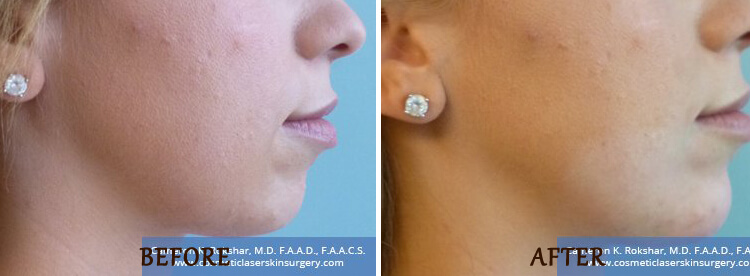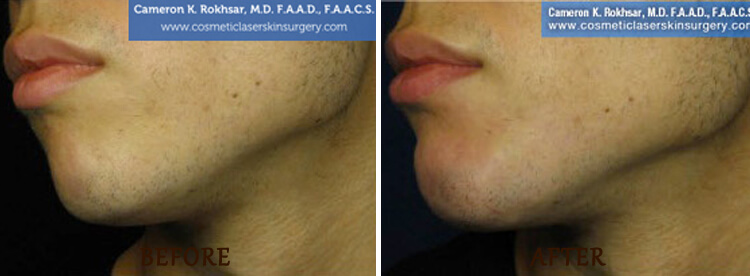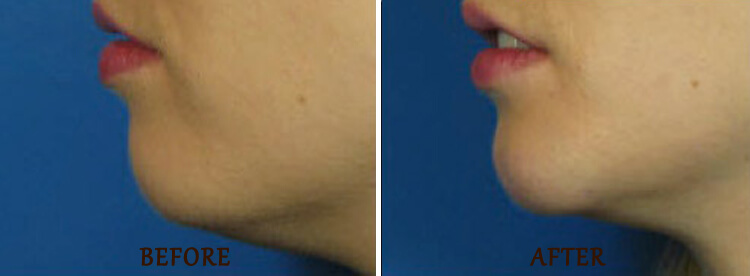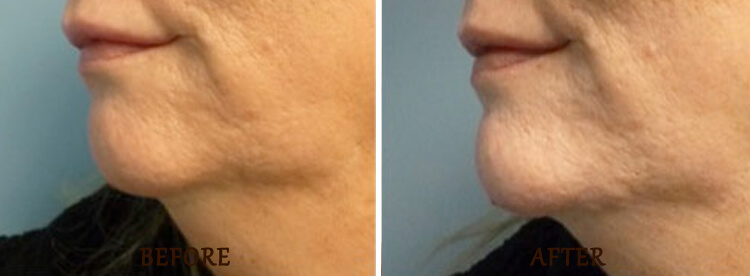Non-Surgical Chin Augmentation in New York
- 1. Benefits of non-surgical chin enhancement
- 2. Chin augmentation fillers
- 3. Non-surgical chin augmentation recovery
- 4. Liquid chin augmentation results
- 5. Best chin augmentation injector in NYC
- 6. Non-surgical chin augmentation reviews
- 7. Non-surgical chin augmentation FAQ
- 8. Request an appointment
- 9. New York office locations
Traditionally, most people believe surgery is the only way to alter the shape of the face. Whether you are unhappy with certain features of your face, or your chin, fillers have become a proven and effective treatment option to reach your cosmetic goals. In people with a recessed or small chin, the chin can be strengthened using the non-surgical chin augmentation approach with filler injections.
Besides creating a stronger-looking and more prominent chin, chin augmentations in NYC can restore balance to the facial profile by creating the illusion of a smaller nose. This is because a receding chin highlights a nose that may not give balance to someone’s face. Although the chin can be augmented either surgically or non-surgically, surgery has become less popular with the advent of robust fillers such as Radiesse and Voluma, and also because people have become warier of the exaggerated and unnatural look of a surgical chin implant.
Double Board-certified dermatologist and dermatologic surgeon, and expert injector, Dr. Cameron Rokhsar has years of experience performing non-surgical chin augmentations 1. To learn more about his work, contact us and book a consultation today.
Benefits of non-surgical chin enhancement
- Safety. Surgery carries inherent risks including scarring, infection, and anesthesia complications. Traditional chin augmentation involves inserting a chin implant under general anesthesia. This implant can, rarely, move after surgery, having to be repositioned. If there is a significant infection after surgery, the implant must be removed. In addition, sometimes the borders of the implanted chin show, giving a very unnatural look. Non-surgical chin enhancement avoids the basic risks of surgery. There is no solid implant, therefore no risk of movement or infection. One of Dr. Rokhsar’s favorite fillers for the chin is Radiesse. Radiesse does not move after it is injected and becomes part of the tissue. Infections are extremely rare with the injection of Radiesse into this area of the face.
- Recovery. Recovery from traditional chin enhancement typically lasts seven to ten days and involves pain, bruising, and swelling. The majority of the swelling goes away after two to four weeks, but some swelling can last several months. If the incision was made inside of the mouth you will need to eat soft foods and use special procedures for brushing your teeth. Strong pain medication, ice packs, and special mouth rinses are required during recovery. Non-surgical chin enhancement results in minor swelling and rarely mild bruising and tenderness. These symptoms should last no more than two to three days.
- Results. Since traditional chin augmentation involves inserting an implant, the enlargement cannot be completely customized to the shape of your face. It is possible for the implant to shift after surgery, which would give an undesirable look and require another surgery. In addition, a chin implant often looks fake with discernable borders. The injectable filler used in non-surgical chin enhancement is injected in small amounts and in precise locations so that there is total control over the shape and contours created by the procedure. Results last up to two years. Because the results are relatively temporary, adjustments can be made as your face changes over time, which allows you to maintain a natural look.
Chin augmentation fillers
Chin augmentation fillers are a non-surgical option for those looking to enhance the shape and definition of their chin and jawline. The procedure involves injecting temporary dermal fillers into the soft tissue under the skin to provide more volume and improve the balance of facial features. This method is a safe, effective alternative to surgical chin augmentation, which involves implanting a plastic material into the chin and adhering it to the bone.
Chin fillers are an excellent choice for people who are concerned about a recessed chin, a deep dimple in their chin, or mild-to-moderate wrinkles. Unlike chin implants, they are less invasive, more affordable, and have fewer risks of side effects and adverse reactions. The procedure is quick, typically taking around 10-15 minutes to complete, and has minimal downtime. Patients can usually return to their daily activities immediately following the treatment.
Radiesse chin augmentation filler
Radiesse is an effective option for chin augmentation, providing a non-surgical alternative to permanent chin implant surgery. Radiesse is a preferred choice for chin augmentation because it is made of tiny microspheres of calcium hydroxylapatite, which gives it a longer-lasting effect compared to other dermal fillers made of hyaluronic acid. In addition, Radiesse is a more rigid filler, matching the bone structure of the chin.
During the procedure, the Radiesse filler gel is administered through a small needle or a microcannula in the marked areas of the chin. This injection provides more volume of filler in a single syringe compared to other hyaluronic acid fillers such as Restylane and Juvederm. The effects of Radiesse filler for chin augmentation can last up to 1-2 years.
Chin augmentation with Radiesse filler can help add definition, balance facial features, restore lost volume, smooth wrinkles, or fill in a cleft. It can also contribute to facial proportion and symmetry, adding definition to facial features. The procedure is typically quick and requires minimal downtime, making it a convenient option for those seeking facial rejuvenation without surgery. In some cases, Radiesse chin augmentation may be combined with other injectable fillers such as Juvederm Voluma to achieve the desired results.
Juvederm chin augmentation filler
Juvederm Voluma is another great option for chin augmentation. It is an FDA-approved, hyaluronic acid-based filler that provides a long-lasting result with minimal side effects. It is specifically designed for deep injection to augment the chin region, improve the chin profile, and create shape and definition for adults over 21 years of age.
Juvederm Voluma is a popular choice among dermatologists and plastic surgeons due to its safety and efficacy. It is a modified form of hyaluronic acid, a natural ingredient found in the body, which makes it an excellent option for people who prefer a non-surgical approach to enhance their chin appearance. Additionally, it can correct mild-to-moderate concerns, such as a weak chin profile, loss of volume due to aging, or a cleft chin.
Bellafill chin augmentation filler
Bellafill is a semi-permanent dermal filler composed of poly methyl methacrylate (PMMA) microspheres that are suspended in a collagen gel. It is FDA-approved for use in treating moderate to severe facial wrinkles and folds, as well as acne scars. It has also been found to be a safe and effective alternative to chin implants and surgical chin augmentation procedures.
One disadvantage to Bellafill is the potential for allergic reactions. It is the only filler that requires skin allergic testing. This is because the body can potentially react to the small plastic microspheres suspended in the filler. Typically a small amount of the filler has to be injected into one arm under the skin. The area needs to be evaluated 6 weeks later to ensure that the patient is not allergic to the material. Typically Dr. Rokhsar likes to do two allergy skin tests for the patient’s safety.
Non-surgical chin augmentation recovery
If you have opted for non-surgical chin augmentation using dermal fillers, the recovery period is minimal. Most patients can resume their normal activities right after the procedure, but some may experience slight redness, or swelling at the injection site. These symptoms are usually mild and resolve within a few hours to a few days. You can apply cold compresses to the treated area to reduce swelling and avoid massaging or rubbing the area.
In the case of non-surgical chin augmentation using fat grafting, the recovery time is slightly longer. You may experience bruising, swelling, and discomfort at the donor site and the chin area. However, these symptoms are generally mild and should subside within a week or two. You may be advised to wear a compression garment or bandage to minimize swelling and provide support to the treated area. It is recommended to avoid strenuous activities, facial massages, and sun exposure during the healing period. Dr. Rokhsar prefers filler injections like Radiesse or Voluma to fat grafting for non-surgical chin jobs.
Liquid chin augmentation results
*Results may vary.
Dr. Rokhsar is the best chin augmentation injector in NYC
Fillers, such as Radiesse, are being used to strengthen and contour the chin to improve the patient’s facial structure. Dr. Rokhsar has years of success in achieving patients’ cosmetic goals with the use of Radiesse to create a brand new chin in minutes without surgery or enhance a weak or recessed chin
Dr. Rokhsar builds a very natural-looking chin because he follows the natural contours of the person’s chin. This allows Dr. Rokhsar to precisely inject small amounts of Radiesse to build the chin and balance the facial profile, which ultimately provides the patients with results as subtle or dramatic as the patient desires. Typically, one syringe of filler suffices to achieve the patient’s desired cosmetic outcome. In patients with a very weak or recessed chin, Dr. Rokhsar may advise using two syringes for the non-surgical chin augmentation. Dr. Rokhsar has the most experience in the non-surgical chin job compared to anyone else in the New York area.
Non-surgical chin augmentation reviews for Dr. Rokhsar
Non-surgical chin augmentation FAQ
How is non-surgical chin augmentation performed?
A non-surgical chin augmentation utilizes the volume-building properties of fillers such as Radiesse, or Juvederm Voluma. Either filler is placed into precise areas of the chin using a small needle. The results give patients an improvement in the face profile and facial symmetry. The non-surgical chin augmentation is performed in one treatment session lasting 10-15 minutes. This is a minor lunch time procedure with patients returning to work or school immediately. Minor swelling and tenderness may last 2 to 3 days post-procedure.
How long does a liquid chin augmentation last?
This minimally invasive non-surgical chin augmentation procedure is ideal for patients of any age who may need further adjustments to their chin structure. It is also ideal for patients who are surgery averse and do not want a chin implant. The results for the liquid chin augmentation can last one to two years depending on the filler used. The FDA has allowed the makers of Radiesse to market the filler as lasting for up to 12 months. The FDA has allowed the makers of Voluma to market the filler as lasting for up to 24 months.
How long does chin filler swelling last?
Swelling after chin filler injections can be expected, but is usually minor. The swelling usually can last a few days or less. In some cases, mild swelling can subside in a few hours. However, if the swelling is severe or lasts longer than a few days, it may be a sign of an allergic reaction to the filler. The duration of the swelling can vary depending on the individual’s body chemistry, the type of filler used, the depth of placement, and the amount of filler used. Chin fillers typically last for 6-24 months. Follow-up treatments will be required to maintain the desired look. It is advisable to consult with Dr. Rokhsar for more information on the specific type of filler used and any potential side effects.
What not to do after chin filler?
After getting chin fillers, it is important to take proper precautions to ensure the best possible results. Here are some things to avoid after receiving chin fillers:
- Avoid applying any heat to the area, such as saunas and hot showers, as well as hot waxing, to prevent bruising.
- Avoid blood thinning products such as garlic, ginger, ginkgo biloba, ginseng, kava, fish oil, Aspirin, Advil, Motrin, and naproxen in your diet for at least a week before and after the procedure to reduce the risk of bruising.
- Avoid strenuous activity for the first 24-48 hours after getting chin fillers and try not to apply too much pressure to your chin during this time to avoid any displacement of the filler.
- Do not wear a tight in the days immediately following your filler injections if you have received fillers in the upper half of your face or your chin. The pressure of certain types of eyewear or masks could potentially cause your filler to migrate beneath the skin.
- Do not get a massage for at least two weeks after getting fillers. Lying on your stomach, with your face pressing into the donut on a massage table can greatly increase swelling, especially if you have had filler in your tear troughs or cheeks.
- Avoid blood-thinning medications like aspirin and ibuprofen for 24-48 hours after the treatment and one week prior to treatment as it may cause swelling and bruising.
Remember to take it easy and allow your filler to settle, avoiding vigorous workouts for the first day after the procedure. Additionally, you can take arnica, a homeopathic supplement that minimizes bruising and speeds up the healing process, and apply ice or a gel ice pack for a few minutes at a time to keep swelling down. Use a gentle cleanser while your face is healing, and if you have any questions or concerns about facial fillers, consult with Dr. Rokhsar.
What to expect after chin filler?
After a chin filler treatment, it is common to experience some minor swelling, tenderness, and bruising at the injection sites. These are normal side effects that usually go away within a matter of hours or days. You may also feel a slight redness, itching, or numbness near the injection site, which can also be expected. Experts recommend avoiding scratching, massaging, or touching the injection site and avoiding strenuous exercise and heavy physical activity for 24-48 hours after the procedure. The chin may feel sore and heavy for a few days, and hard chewing should be avoided during this time. Most conditions can be alleviated with topical icing and massage and will improve within a matter of hours or just a few days. If you experience a hypersensitivity reaction that can seem like an allergic reaction with hives and swelling, seek medical attention immediately. However, these side effects happen often and will usually self-resolve in the days after your treatment.
The procedure itself is relatively quick, and chin filler injections are similar to other dermal filler procedures. The amount of filler injected is specific and strategically placed into the chin. There is no downtime required, and the treatment is performed by Dr. Rokhsar in the office in a matter of minutes.
Lastly, the cost of chin filler treatments varies depending on the type of filler used, with some popular options being Restylane Lyft, Juvederm, volume, and Radiesse.
How much does a non-surgical chin augmentation cost?
The cost of chin augmentation can vary depending on several factors, such as the type of procedure, location, surgeon’s experience, and related expenses.
There are different types of chin augmentation procedures, such as chin implants and chin fillers. Chin fillers, which are nonsurgical and involve injecting fillers to enhance the appearance of the chin, can also vary in cost depending on the type of filler used and the amount needed.
Overall, the cost of chin augmentation can vary significantly depending on various factors, and it’s important to consult with Dr. Rokhsar for an accurate cost estimate.
How is non-surgical chin augmentation performed?
A non-surgical chin augmentation utilizes the volume-building properties of fillers such as Radiesse, or Juvederm Voluma. Either filler is placed into precise areas of the chin using a small needle. The results give patients an improvement in the face profile and facial symmetry. The non-surgical chin augmentation is performed in one treatment session lasting 10-15 minutes. This is a minor lunch time procedure with patients returning to work or school immediately. Minor swelling and tenderness may last 2 to 3 days post-procedure.
How long does a liquid chin augmentation last?
This minimally invasive non-surgical chin augmentation procedure is ideal for patients of any age who may need further adjustments to their chin structure. It is also ideal for patients who are surgery averse and do not want a chin implant. The results for the liquid chin augmentation can last one to two years depending on the filler used. The FDA has allowed the makers of Radiesse to market the filler as lasting for up to 12 months. The FDA has allowed the makers of Voluma to market the filler as lasting for up to 24 months.
How long does chin filler swelling last?
Swelling after chin filler injections can be expected, but is usually minor. The swelling usually can last a few days or less. In some cases, mild swelling can subside in a few hours. However, if the swelling is severe or lasts longer than a few days, it may be a sign of an allergic reaction to the filler. The duration of the swelling can vary depending on the individual’s body chemistry, the type of filler used, the depth of placement, and the amount of filler used. Chin fillers typically last for 6-24 months. Follow-up treatments will be required to maintain the desired look. It is advisable to consult with Dr. Rokhsar for more information on the specific type of filler used and any potential side effects.
What not to do after chin filler?
After getting chin fillers, it is important to take proper precautions to ensure the best possible results. Here are some things to avoid after receiving chin fillers:
- Avoid applying any heat to the area, such as saunas and hot showers, as well as hot waxing, to prevent bruising.
- Avoid blood thinning products such as garlic, ginger, ginkgo biloba, ginseng, kava, fish oil, Aspirin, Advil, Motrin, and naproxen in your diet for at least a week before and after the procedure to reduce the risk of bruising.
- Avoid strenuous activity for the first 24-48 hours after getting chin fillers and try not to apply too much pressure to your chin during this time to avoid any displacement of the filler.
- Do not wear a tight in the days immediately following your filler injections if you have received fillers in the upper half of your face or your chin. The pressure of certain types of eyewear or masks could potentially cause your filler to migrate beneath the skin.
- Do not get a massage for at least two weeks after getting fillers. Lying on your stomach, with your face pressing into the donut on a massage table can greatly increase swelling, especially if you have had filler in your tear troughs or cheeks.
- Avoid blood-thinning medications like aspirin and ibuprofen for 24-48 hours after the treatment and one week prior to treatment as it may cause swelling and bruising.
Remember to take it easy and allow your filler to settle, avoiding vigorous workouts for the first day after the procedure. Additionally, you can take arnica, a homeopathic supplement that minimizes bruising and speeds up the healing process, and apply ice or a gel ice pack for a few minutes at a time to keep swelling down. Use a gentle cleanser while your face is healing, and if you have any questions or concerns about facial fillers, consult with Dr. Rokhsar.
What to expect after chin filler?
After a chin filler treatment, it is common to experience some minor swelling, tenderness, and bruising at the injection sites. These are normal side effects that usually go away within a matter of hours or days. You may also feel a slight redness, itching, or numbness near the injection site, which can also be expected. Experts recommend avoiding scratching, massaging, or touching the injection site and avoiding strenuous exercise and heavy physical activity for 24-48 hours after the procedure. The chin may feel sore and heavy for a few days, and hard chewing should be avoided during this time. Most conditions can be alleviated with topical icing and massage and will improve within a matter of hours or just a few days. If you experience a hypersensitivity reaction that can seem like an allergic reaction with hives and swelling, seek medical attention immediately. However, these side effects happen often and will usually self-resolve in the days after your treatment.
The procedure itself is relatively quick, and chin filler injections are similar to other dermal filler procedures. The amount of filler injected is specific and strategically placed into the chin. There is no downtime required, and the treatment is performed by Dr. Rokhsar in the office in a matter of minutes.
Lastly, the cost of chin filler treatments varies depending on the type of filler used, with some popular options being Restylane Lyft, Juvederm, volume, and Radiesse.
How much does a non-surgical chin augmentation cost?
The cost of chin augmentation can vary depending on several factors, such as the type of procedure, location, surgeon’s experience, and related expenses.
There are different types of chin augmentation procedures, such as chin implants and chin fillers. Chin fillers, which are nonsurgical and involve injecting fillers to enhance the appearance of the chin, can also vary in cost depending on the type of filler used and the amount needed.
Overall, the cost of chin augmentation can vary significantly depending on various factors, and it’s important to consult with Dr. Rokhsar for an accurate cost estimate.
New York Office Locations
Upper East Side Manhattan Office
121 East 60th Street, Suite 8AB New York, NY 10022
(212) 285-1110
Long Island Office
901 Stewart Ave, Suite 240, Garden City, NY 11530
(516) 512-7616
Request an Appointment
References
- Role of Nonsurgical Chin Augmentation in Full Face Rejuvenation: A Review and Our Experience. Available: https://pubmed.ncbi.nlm.nih.gov/29309340/.
- ArteFill® Permanent Injectable for Soft Tissue Augmentation: II. Indications and Applications. Available: https://www.ncbi.nlm.nih.gov/pmc/articles/PMC2872008/.







 Dr. Rokhsar was chosen by
Dr. Rokhsar was chosen by 






